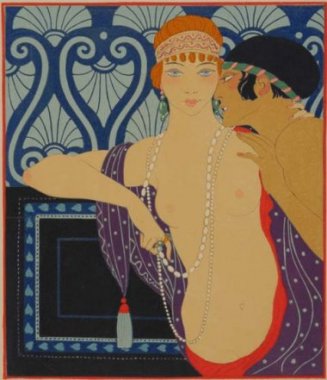Collectioners, aristocratic bibliophiles and the exquisite elite of the beau-monde were enthusiast about him. They loved his inventiveness and the ability to create subtle moods and style. Afterwards it was oblivion, for a very long time. George Barbier (1882 – 1932) was an illustrator, costume and stage designer, initiator of magazines and much more. Palazzo Fortuny Museum has organized an exhibition (until January 5), curated by Barbara Martorelli, to remember the initiator of Art Deco, an illustrious stranger whose story was left somehow “interrupted”. Barbier died in 1932, he was fifty years old, very successful and childless. Six months later all his collection, his precious library included, was sold out in an auction in mysterious circumstances. Short after he was completely forgotten. The gentle and vertical line of his compositions fit very well in the “labyrinthine” palace that hosts the show and that once belong to Mariano Fortuny. Daniela Ferretti’s exhibition design evokes the elegance of Art Deco. George was interested in the work of Henry de Règnier, Gabriele D’Annunzio and Gerard d’Houville. Nevertheless his graphic line and his intentions are more controlled and “disinfected”, kept away from extreme aestheticism. Even if extremely thin and fragile, his characters are healthy and never fading. A “classic” spirit supports the bodies that never twist but breath deeply against the clear background. The attention of the artist is always directed towards the body and the human figure. Hellenic élan, mythological motives are traceable in the sketches for film costumes, in the drawings for Cartier’s jewellery and in the illustrations of contemporary tales.
He was born in a French provincial town at the end of the nineteenth century. He was the son of a shopkeeper and since the beginning he had no doubt about his “calling”. His unique initial inspiration was Vaudoyer’s biography, published by “Les Artistes du livre”. We can see him very concentrated while he reproduces Watteau’s painting or the “Dame” by Ingres in the local museum of Fine Arts. In 1922 he wrote an essay where he clearly expressed his neoclassical and Parnassian beliefs. As proven by many of his images, he surely admired Aubrey Beardsley and the Pre-Raphaelite atmospheres of William Morris and his peers. Obviously Barbier always maintained his own mark and characteristics, derived from his French “bubbly” and libertine attitude, very much light-hearted and little esoteric. The curator says: “He shows a detached smile to cubism, he laughs at the word “avant-garde”. (…) he loves beauty, the line and rigorous shapes (…) he defends Japanese prints’ decorativism, he loves Venetian 18th-Century Art”.
The encounter that, above all, represented a turning point for him is the one with his industrial patron Alphonse Lotz-Brissonneau, a passionate collector of his art. Between his master pieces are the oriental atmospheres in “Shèrhérazade” for the magazine “Modes et Manières d’Aujourd’hui”, the beautiful editions inspired by Russian ballet dedicated to the “Tragedy of Nijinsky”, and five small books “La Guirlande Desmois” (1917-1921) edited by Meynal. He was very fascinated by Venice, its romantic labyrinths, the intrigues and nocturnal frolics, from the city he took inspiration to illustrate a voyeuristic version of the adventures of a vain philosopher-Casanova. He was attracted by the texture of the lagoon’s water after a storm welcomed him at his arrival in Venice: “ a silver veil covers the water, looking like crystal, sparkles flicker as absinth drops in a glass, the opal blue merges with the sky…”.



